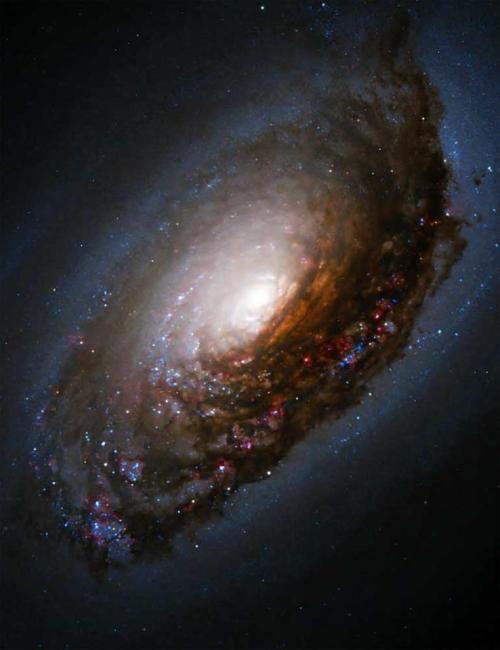BLACK EYE GALAXY
The Black Eye Galaxy, otherwise known as Messier 64 or the Evil Eye galaxy is a merged star system formed from the collision from two galaxies. It was first catalogues by the French astronomer Messier in the 18th century. It is located in the northern constellation Coma Berenices and is about 17 million light years from Earth. There is a dark band of absorbing dust in front of th e galaxy’s nucleus, giving rise to the nicknames.
Like most galaxies, all of the stars of M64 are rotating in the same direction; however the interstellar gas in the outer regions of M64 rotates in the opposite direction from the gas and stars in the inner regions. In the shear region where the oppositely rotating gases collide and compress there is active formation of new stars. The blue stars visible are hot and young; there are also pink clouds of glowing hydrogen that fluoresce when exposed to ultraviolet light from these newly formed stars.
The gas that is rotating oppositely probably arose when M64 absorbed a satellite galaxy that collided with it, maybe more than one billion years ago. The small galaxy has been almost completely destroyed, but evidence of the collision remains in the backward motion of the gas at the outer edge of M64.
This image was obtained with Hubble’s Wide Field Planetary Camera 2 (WFPC2). The colour image is a composite, prepared by the Hubble Heritage Team from pictures taken through four different colour filters. The filters isolate blue and near infrared light, as well as red light emitted by hydrogen atoms and
green light from Strömgren y.
http://www.skyimagelab.com/black-eye-galaxy.html
Image Credit: NASA and The Hubble Heritage Team (AURA/STScI)
Σάββατο 29 Σεπτεμβρίου 2012
BLACK EYE GALAXY
Εγγραφή σε:
Σχόλια ανάρτησης (Atom)

Δεν υπάρχουν σχόλια:
Δημοσίευση σχολίου